North Korea’s nuclear strategy may be moving toward “limited use” with its growing nuclear stockpiles to further strengthen deterrence against conventionally superior adversaries including the U.S., an American expert said Thursday.

Joel Wit, a senior fellow with the U.S.-Korea Institute at the Johns Hopkins University’s School of Advanced International Studies, also noted that over the last decade or so, Pyongyang’s strategy has been based on the concept of “assured destruction” -- a nuclear strategy to ensure deterrence through the threat of overwhelming nuclear counterstrikes.
“Typically, as countries build more and more nuclear weapons, they start thinking about different options for using them. So what we are seeing is thinking about limited options ... not so much that they are planning on using them, but just as a way of bolstering deterrence,” he said during a seminar arranged by local think tank Asan Institute for Policy Studies.
“It wouldn’t be surprising because countries who face conventionally superior opponents often go to the possibility of limited nuclear use early in a timeframe in order to deter those conventionally superior opponents. So a prime example nowadays is Pakistan facing India.”
Wit said that the “overriding principles” of Pyongyang’s nuclear strategy include the maintenance of its autocratic regime, deterrence against its potential adversaries, such as the U.S. and South Korea, and reunification on “its own terms.”
Touching on the implications of North Korea’s possession of nuclear arms with regard to the peninsular reunification, the scholar painted a negative outlook.
“I hate to say it, but a nuclear North Korea is not going to be reunifying with anyone except on its own terms, and the fact that it has nuclear weapons, that certainly strengthens that position for them,” he said.
Despite international worries, the North has continued to develop its nuclear program, adopting “Byungjin line” policy of pursuing the development of nuclear arms and its economy simultaneously. It has also called itself a nuclear power in its constitution, although the U.S. and South Korea have not accepted that.
Referring to the U.S.’ hitherto policy on the North, Wit underscored the “consensus” in Washington that the policy was not successful. He described the U.S. policy, which commentators often call “strategic patience,” as a “strategic coma,” an expression that Victor Cha, a North Korea expert at the Center for Strategic and International Studies, coined.
“There is a consensus that the policy isn’t working. There is no consensus on what to do and this is a problem,” he said.
To make progress in finding solutions to the North’s nuclear problem, he proposed talks through which Washington and Pyongyang could discuss formulating a peace treaty in return for the North’s denuclearization.
Pyongyang has repeatedly called for peace treaty talks with Washington. But the U.S. has been reluctant to hold treaty talks as the North’s definition of the treaty involves the withdrawal of U.S. forces on the peninsula and end of the U.S.’ guarantee of the nuclear umbrella for the South, both of which would shake the foundation of the Seoul-Washington alliance.
“One of the things I think we should do is to say to North Koreans that we are happy to sit down tomorrow and negotiate a peace treaty and, by the way, part of that negotiation should be denuclearization,” he said.
“Because if a peace treaty is addressing your threat perceptions, the denuclearization addresses our threat perception. It is going to be complicated and difficult, but in fact, North Koreans have raised this possibility privately in the Track II meetings. And that was 2013 and 2014.”
As for the North’s stockpile of nuclear weapons, Wit said based on his research team’s analysis that Pyongyang could secure a maximum of 100 nuclear arms by 2020 “if things go very well” with its overall nuclear program.
By Song Sang-ho (sshluck@heraldcorp.com)



![[AtoZ into Korean mind] Humor in Korea: Navigating the line between what's funny and not](http://res.heraldm.com/phpwas/restmb_idxmake.php?idx=644&simg=/content/image/2024/04/22/20240422050642_0.jpg&u=)


![[Herald Interview] Why Toss invited hackers to penetrate its system](http://res.heraldm.com/phpwas/restmb_idxmake.php?idx=644&simg=/content/image/2024/04/22/20240422050569_0.jpg&u=20240422150649)
![[Graphic News] 77% of young Koreans still financially dependent](http://res.heraldm.com/phpwas/restmb_idxmake.php?idx=644&simg=/content/image/2024/04/22/20240422050762_0.gif&u=)




![[Exclusive] Korean military set to ban iPhones over 'security' concerns](http://res.heraldm.com/phpwas/restmb_idxmake.php?idx=644&simg=/content/image/2024/04/23/20240423050599_0.jpg&u=20240423171347)


![[Exclusive] Korean military to ban iPhones over security issues](http://res.heraldm.com/phpwas/restmb_idxmake.php?idx=652&simg=/content/image/2024/04/23/20240423050599_0.jpg&u=20240423171347)



![[Today’s K-pop] Ateez confirms US tour details](http://res.heraldm.com/phpwas/restmb_idxmake.php?idx=642&simg=/content/image/2024/04/23/20240423050700_0.jpg&u=)